Deep Impact
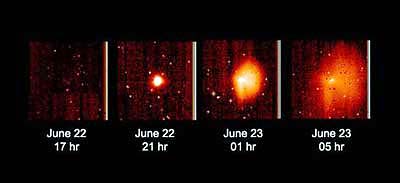
An outburst of sublimated gases on Tempel 1, as imaged by the Deep Impact probe about ten days before impact. (Image credit: NASA/JPL-Caltech/UMD/T. Farnham)
Comets are relics from the origin of the solar system, carrying material about 4.5 billion years old. Sometimes described as “dirty snowballs,” they’re a mixture of rocks and ices of various compounds, with a surface layer altered by meteor impacts and solar heating. To expose the primordial material, a University of Maryland-led NASA mission named Deep Impact was launched in January of 2005. The mission’s two co-joined spacecraft (see drawing) were designed to journey to Tempel 1, where the “impactor” craft would separate, crash into the comet, and eject inner cometary matter into nearby space.
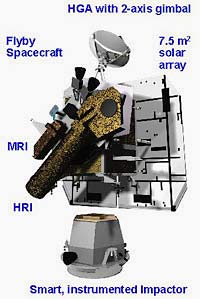
The Deep Impact probe, showing the impactor and the flyby spacecraft;. HGA: High-Gain Antenna; MRI: Medium-Resolution Instrument; HRI: High-Resolution Instrument (image courtesy of NASA).
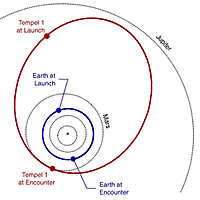
The orbit of comet Tempel 1, located in the region between the orbits of Mars and Jupiter (image courtesy of Tony Farnham/University of Maryland)
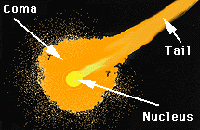
A comet’s nucleus, coma, and tail (image courtesy of NASA)
Most comets inhabit the two great “clouds,” one in the vicinity of the orbit of Neptune—where Tempel 1 originated—and one extending hundreds of times further out than the orbit of Pluto. The inner cometary material ought to be very similar to the material of the outer planets. The comets we see were presumably disturbed by the gravity of some other star and now move in elliptical (non-circular) orbits, such as the orbit of Tempel 1 shown in the drawing. This comet, the target of Deep Impact, orbits the sun every five and a half years, moving between the orbits of Mars and Jupiter .
As a comet’s nucleus (see the image of comet parts) nears the sun, its temperature rises because of the absorption of solar radiation. The comet’s ices sublime—that is, convert directly from solid to gas—spitting out gas in jets that drag dust and solids along to form the coma. The series of images shows one of these outbursts in Tempel 1, captured by Deep Impact about a week before their head-on collision.
To determine the chemical composition of the nucleus, astronomers study the spectral lines in the light given off by the coma. This isn’t as straightforward as it sounds, though, because after these molecules sublime, they promptly dissociate (split) due the absorption of sunlight, so only the products of the dissociation can be identified. What the comet is made of must be inferred from these by-products, unless the spectrometer is very close to the nucleus.
In recent years, probes have captured detailed images of comets, but getting information about the comet’s chemical composition has been much more difficult, and that’s where Deep Impact comes in. It was designed to place a probe in the path of comet Tempel 1 so that the resulting crash would break through the outer layer of the comet. And it carried an infrared spectrometer designed to observe the comet’s spectra both before and after impact.
On July 3, 2005 , twenty-four hours before impact with Tempel 1, the washing-machine-size impactor and the flyby craft separated, with the impactor relying on its own computer and steering jets to hit the target. The 6 km diameter comet was then 860,000 km (about twice the Earth-moon distance) away but closing fast, at 10 km/s (23,000 mi/hr). After three bursts from the steering jets, the impactor scored a direct hit. The crash and its aftermath were imaged by a network of telescopes both on Earth and in space.
Research
The first two images show how Tempel 1, in the minutes before impact, filled the field of view of the impactor’s camera. The surface is dark and reddish—reflecting only about 4% of the light that strikes it—like other comets that recently have been observed close-up.
The impactor struck the comet’s surface at an angle of about 30 degrees. With a speed of 10 km/sec, the 370 kg impactor released 19 gigajoules of energy, equivalent to the explosion of about 5 tons of TNT, vaporizing a significant fraction of the impactor and some comet material and spewing a plume of gas and dust into space.
The view from Deep Impact's probe...
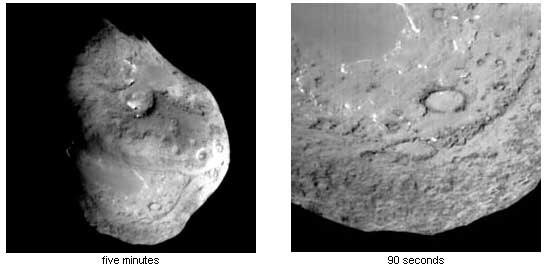
... before it was pummeled by comet Tempel 1. The images were taken by the probe's impactor targeting sensor. (image and caption: NASA/JPL-Caltech/UMD)
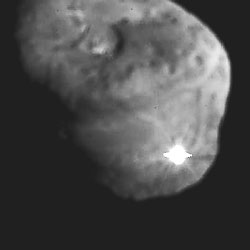
This image shows the initial ejecta that resulted when NASA's Deep Impact probe collided with comet Tempel 1 at 10:52 p.m. Pacific time, July 3 (1:52 a.m. Eastern time, July 4). It was taken by the spacecraft's high-resolution camera 13 seconds after impact. The image has been digitally processed to better show the comet's nucleus.
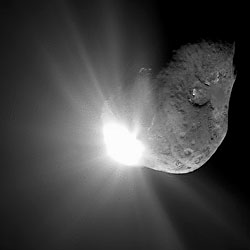
This spectacular image of comet Tempel 1 was taken 67 seconds after it obliterated Deep Impact's impactor spacecraft. The image was taken by the high-resolution camera on the mission's flyby craft. Scattered light from the collision saturated the camera's detector, creating the bright splash seen here. Linear spokes of light radiate away from the impact site, while reflected sunlight illuminates most of the comet surface. The image reveals topographic features, including ridges, scalloped edges and possibly impact craters formed long ago.
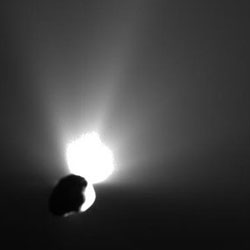
This image shows the view from Deep Impact's flyby spacecraft as it turned back to look at comet Tempel 1. Fifty minutes earlier, the spacecraft's probe had been run over by the comet. That collision kicked up plumes of ejected material, seen here streaming away from the back side of the comet. This image was taken by the flyby craft's high-resolution camera. (images and captions: NASA/JPL-Caltech/UMD )
The next three images show the plume at successive times after impact, as captured by the flyby spacecraft. The brightness of the plume and the number of particles in it were a surprise—it turned out to be brighter, larger, and more opaque than expected, indicating that the comet’s nucleus is covered with a talcum-like powder rather than a frozen mixture of macroscopic rocks and chunks of ice. In fact, the plume completely blocked the view of the impact crater, precluding the observation of the crater dimensions, which would have provided additional information about the layering of the comet.
To infer the comet’s mass, the researchers analyzed the expansion and fallback of the plume, whose particles moved as projectiles under the influence of the comet’s gravitational field. The resulting gravitational acceleration was about 3 x 10-4 m/s2 (compare with 9.8 m/s2 at Earth’s surface).
In the feeble gravity of Tempel 1, the escape velocity is only about 1.4 m/s, as opposed to 11 km/s on the surface of Earth. If an object on Earth were thrown upward with the escape velocity on Tempel 1, the object’s maximum height would be only .1 m.
The comet’s radius, determined to be 3 km, and the abovementioned acceleration of gravity imply a density of about .4 grams/cm3, less than half the density of ice. About 70% of the nucleus is empty space, and the texture of its surface is similar to powdery snow .
By measuring energy radiated from regions of the comet’s surface in sunlight and in shadow, project scientists concluded that the surface warms and cools readily. This result, like the determination of density mentioned above, points to a loose accumulation of grains, rather than a solid slab of ice (A slab’s smaller surface-to-mass ratio would have produced a much slower rate of temperature change.)
Spectroscopic study of light emitted by the plume showed the ejected material to be rich in organic compounds, far more so than in observations of the comas of other comets. This difference may be due to the ejection of material from the interior of the comet, as opposed to the passive spectroscopic observations of the coma in other comet investigations.
Spectroscopic study of sunlight reflected from Tempel 1’s nucleus provided the first direct evidence for the presence of water ice on a comet. Regions whose spectra showed absorptions characteristic of ice correlated with small bright regions on the nucleus. These regions of ice are so small—only about .5% of the surface—that they cannot account for the large amounts of water observed in the coma, so presumably subsurface ice contributes to coma formation.
With the crash and flyby, Deep Impact did its job, but it may yet have an encore performance. A 900-second burn on July 21 placed the craft on a trajectory bringing it back near Earth on December 31, 2007 . NASA is now soliciting proposals for the use of the flyby spacecraft for a different project.
And there’s plenty of other activity in comet research. On January 15, 2006 , the second Stardust spacecraft, which flew within 300 km (180 mi) of comet Wild 2 to collect a sample of cometary particles, successfully parachuted to Earth. Much more ambitious is Rosetta, a European Space Agency (ESA) probe launched in 2004 that will eventually fly alongside Comet 67P/Churyumov-Gerasimenk. In 2014—we’ll have to be patient—Rosetta will release a soft-lander to drop down to the surface and analyze the cometary material.
Links
NASA/JPL/UMD
NASA
European Space Agency
Science North
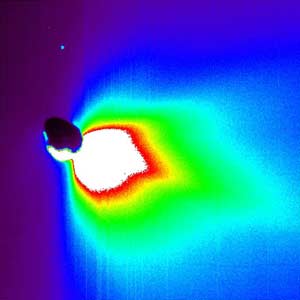
Comet Tempel 1 about 50 minutes after impact, as seen in false color by the flyby spacecraft. The dust plume and a portion of the comet are backlit by the sun. (Image courtesy of NASA/JPL-Caltech/UMD)














